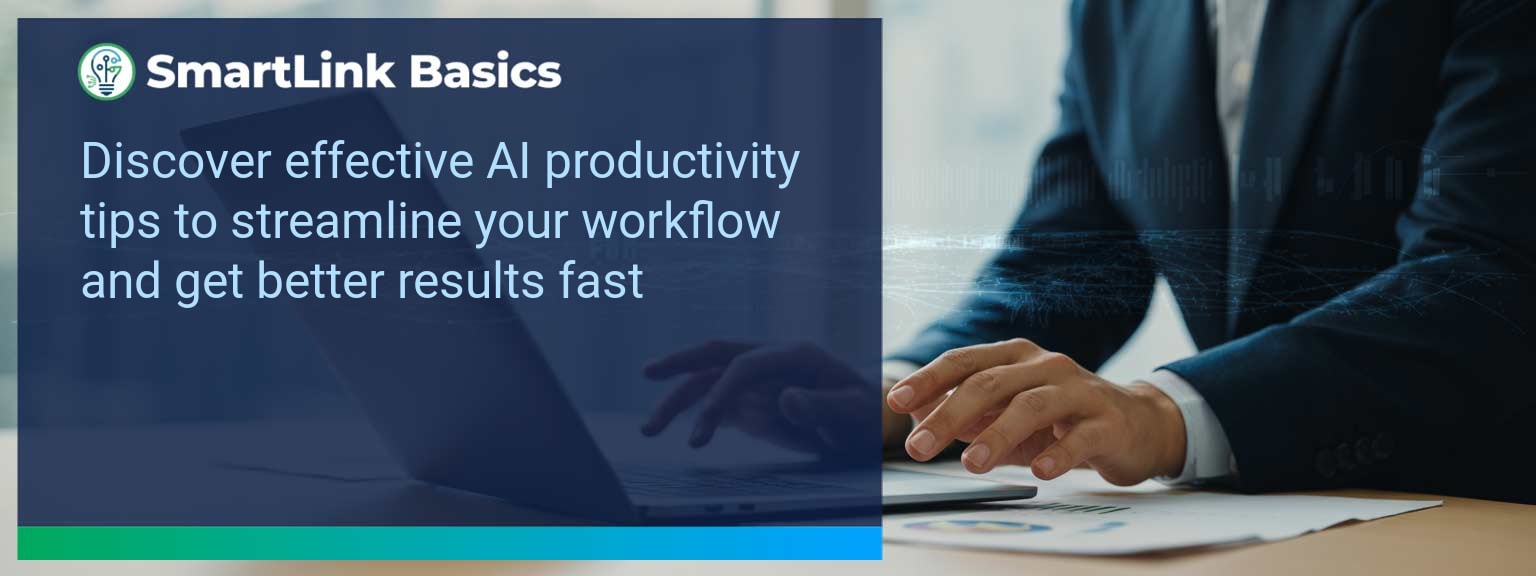Artificial intelligence now underpins critical operational decisions in high-performing sales organizations, and productivity gains are measurable for leaders who use it strategically. According to McKinsey (2023), companies embedding AI into their workflows report efficiency improvements of up to 40%. At SmartLink Basics, we see AI productivity tips as a cornerstone of competitive advantage in sales enablement. Applied correctly, AI reduces wasted motion, optimizes time management, and ensures sales teams hit and sustain peak output. This article provides sales leaders with ten actionable AI-driven strategies to boost productivity with AI, restructure workflows for consistency, and strengthen decision-making speed. You will discover the common productivity blockers, see how AI resolves them, and understand how to implement each solution in the next 90 days.
- Use AI-powered analytics to prioritize high-yield sales activities
- Automate repetitive administrative tasks with AI task automation tools
- Optimize cross-team alignment through shared AI-driven dashboards
- Personalize customer engagement using machine learning recommendations
- Continuously refine workflows through AI-generated performance insights
AI Productivity Tips: Aligning Actions with High-Value Outcomes
Sales productivity drops when teams devote time to low-impact activities. AI tools identify bottlenecks, recommend highest-ROI tasks, and dynamically reprioritize pipelines. For example, an AI-enabled CRM can instantly flag accounts with the greatest revenue potential, eliminating manual list review. Sales leaders should integrate such tools into daily standups, ensuring every rep focuses on the most profitable leads. The result is measurable time reclaimed for core selling activities.Redesigning the Revenue Operating System with AI Productivity Tips
ICP, Segmentation, and Targeting: AI enriches lead data, enabling precise targeting far beyond static segmentation models. This improves conversion likelihood from initial outreach. Pipeline Architecture: Predictive AI models highlight stage-by-stage leak points, allowing teams to address risk before revenue loss occurs. Plays and Messaging: Generative AI customizes messaging frameworks to buyer personas, producing higher engagement rates in less time. Operating Cadence: AI-driven scheduling ensures optimal follow-up sequences, removing guesswork from timing and frequency. Embedding these methods into the revenue operating system ensures efficiency is built into every process from acquisition to close.Common Obstacles To Staying Productive
Leaders report three recurring obstacles: information overload, inconsistent process discipline, and low actionable data visibility. Without structured data interpretation, decision-making slows. For example, a frontline sales manager might spend hours reconciling conflicting reports. By unifying data streams into a single AI-powered interface, these delays disappear. Teams should assign clear data stewardship roles to ensure consistent input for AI systems, thus maintaining high trust in automated outputs.Leveraging AI For Smarter Workflows
AI efficiency strategies accelerate deal cycles by offloading manual, repetitive steps. Intelligent meeting assistants summarize calls and auto-log follow-ups, sparing reps from post-call admin work. In pipeline reviews, AI can instantly detect gaps in buyer engagement and recommend corrective plays. Leaders should pilot workflow automation in one sales pod before rolling companywide, allowing controlled measurement of lift. Over time, automating low-value steps produces sustained energy for higher-impact selling.Significant Gains In Output And Accuracy
Implementing AI work hacks reduces rework, accelerates cycle times, and tightens forecast accuracy. In one SaaS case, integrating AI email sequencing lifted meeting bookings by 22% in six weeks. AI not only delivers efficiency but also strengthens predictive capabilities, giving leaders forward-looking insight into team performance. To scale results, standardize AI tool usage across all sellers and integrate the resulting intelligence into pipeline governance.Emerging Ways AI Will Shape Productivity
Upcoming AI capabilities will predict individual rep performance dips before they occur, offering targeted coaching prompts. Digital productivity tools will proactively restructure daily task lists based on evolving buyer signals. Leaders who adopt early will consistently outperform, as their operating cadence remains tuned to market shifts. To stay ahead, regularly evaluate AI toolsets against emerging capabilities and retire those lagging in adaptability.Metrics That Matter
| Category | Metric | Definition | Target |
|---|---|---|---|
| Leading | AI-Qualified Opportunities | Prospects flagged by AI as highly likely to convert | +25% QoQ |
| Lagging | Closed-Won Rate | Percentage of opportunities converted to closed-won | >30% |
| Quality | Forecast Accuracy | Variance between forecasted and actual revenue | ±5% |
Get the 90-day plan, coaching rubric, and dashboard template to operationalize AI in your enablement program.









